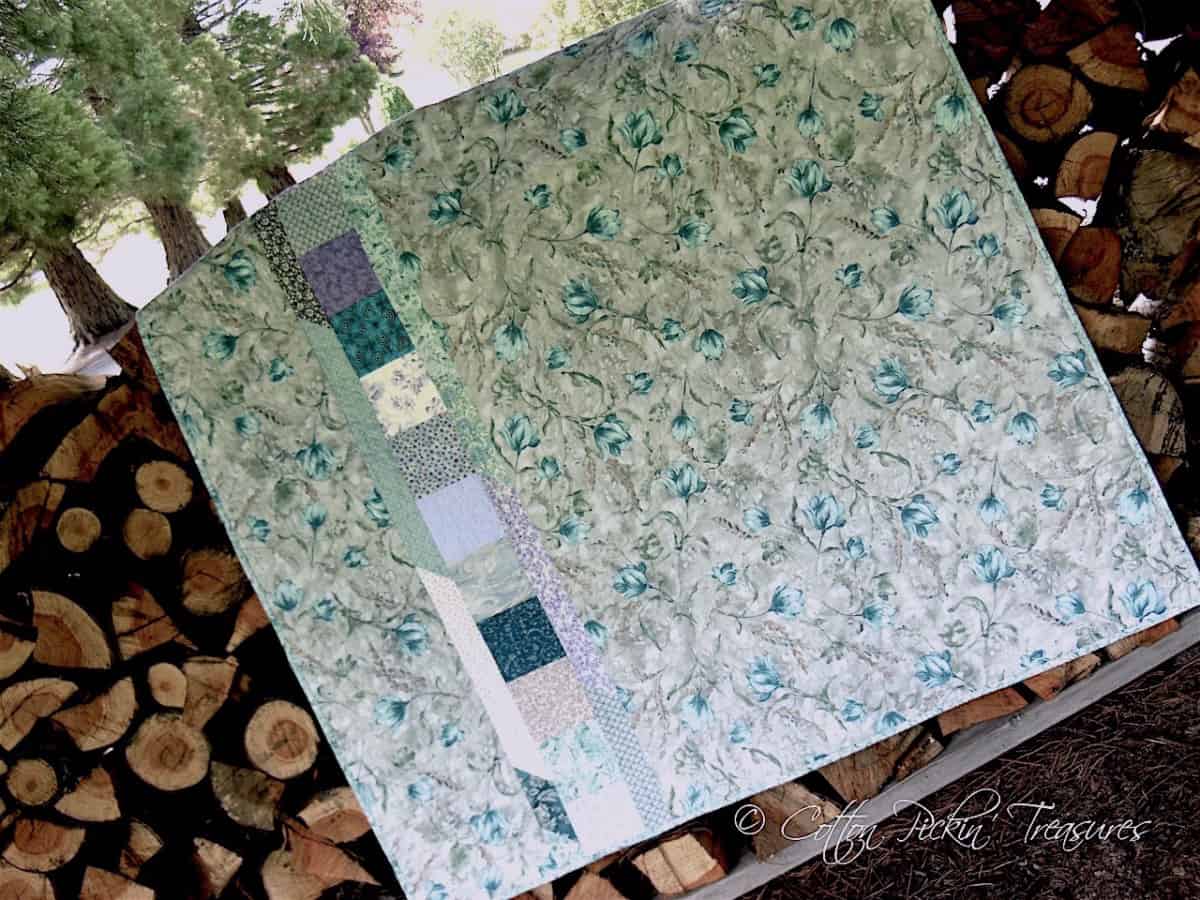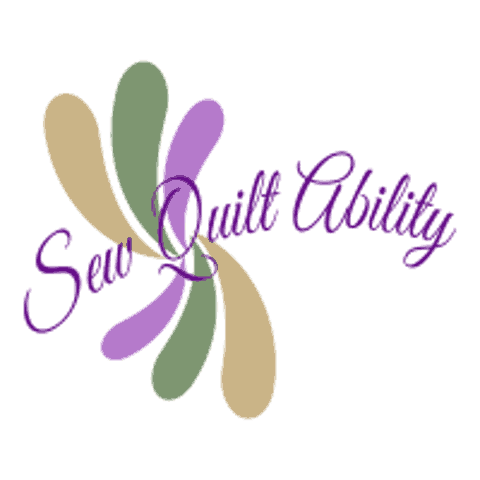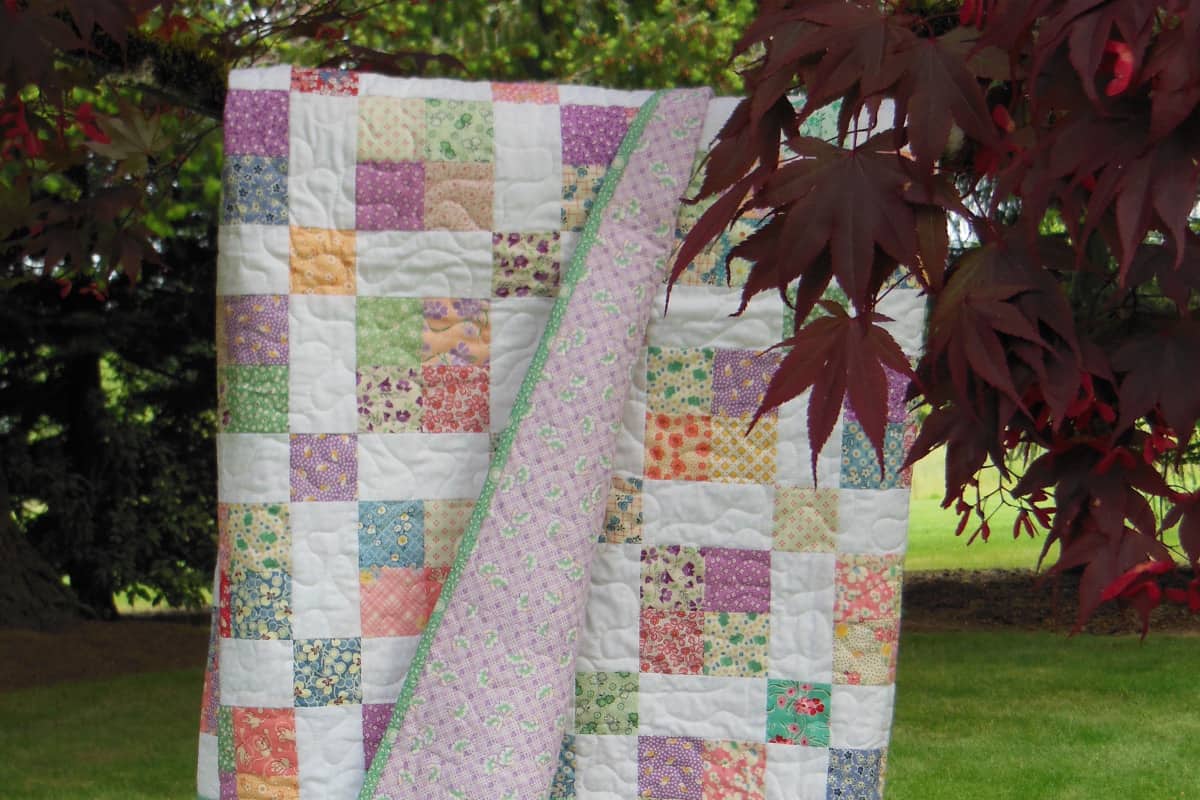You’ve decided to make a quilt.
You have chosen all the fabrics for the quilt top but what about the back?
What should you use, what kind of fabric is best, how big should the backing be and should it be a solid fabric or several pieces sewn together?
These are just a few of the questions you might have running around in your head about the quilt backing when you first start quilting.
This is why from my years of quilting experience I’m sharing what backings are, what fabrics are best and a whole lot more that you need to know to be successful when making a quilt.
A quilt backing is a very important part of a quilt.
Although you can use almost anything for backings, it depends on several things such as how much you want to spend, what fabrics are in the quilt top and how the quilt will be used to name just a few.
I remember the first quilt I made many years ago.
At the time the only kind of fabric that I would see on quilts was muslin.
So… when I started quilting that’s what I backed my first quilt with, a natural muslin fabric.
After making that first quilt of mine with it’s muslin backing and a little time went by I started noticing quilts with such lovely colorful backs, even creative pieced backs that were simply stunning.
How different and more beautiful those quilts were with their backs of patterned fabrics.
I decided from then on that I would back my quilts with fabrics in prints that coordinated with the quilt top.
Sometimes I have even pieced my backs making them reversible quilts.
Although you can choose a few different fabrics to make your quilt from, I do prefer cotton.
Because cotton is a natural fabric it washes easily, feels soft and cozy while also performing well for quilts.
What Is Quilt Backing
Quilt backing, also called the back, is the bottom or third layer of fabric of a quilt “sandwich”.
The quilt top features the design of a quilt where as most backings use fabric that doesn’t have any patchwork or applique designs on it.
It isn’t uncommon though to see backings that are pieced from several different fabrics.
Or even created by using extra blocks added to the backing pieces.
It’s yet another area where you can use your talents to create another piece of art!
When making larger quilts, backings will have to be pieced since most 100% quilting quality fabric yardage isn’t wide enough.
Plan when possible to have two equally placed seams in the backing rather than one seam that is down the middle.
Two seams are usually more pleasing to the eye.
If you are piecing your backing its a good idea use a 1/2″ seam and to press all the seam allowances open.
Pressing the seam open prevents there being added bulk to the quilt when you are quilting it.
The wider seam allowance gives that seam in the back a little more durability.
Make sure to also remove the selvages before you make your 1/2″ seam.
Selvages can cause distortion and/or puckering so removing them is always a good thing to remember to do.
If you would rather not piece your back, wider fabrics can be found that are made for backings in widths up to 108 inches.
Finding a nice variety in these wide fabrics is pretty slim though there are many beautiful ones to choose from.
How large you make your backing is determined on the size of your finished quilt top.
Your backing should be at least 3-4″ larger on all sides than your quilt top.
This gives the extra fabric needed for longarm quilters to have some fabric to attach to their longarm frames.
It’s also what is needed if quilting it yourself making it so much easier, giving a little extra wiggle room for centering the quilt top when making your quilt sandwich.
What Kind Of Fabric Is Used For Quilt Backing
The best backing for a quilt is 100% quilting quality fabric, especially if your quilt top is of these same quilting quality fabrics.
There are other choices that can be used such as flannels, muslin, minky and fleece.
Since your quilt will probably be around for a long time, it really is worth selecting the best quality fabric that you can afford.
When choosing a quilt back you want to select fabric of similar quality to the fabrics that you used in the quilt top.
When the fabrics being used for the front are compatible with the fabrics on the back your finished quilt will have more durability.
The wash-ability will be better and more consistent for the finished quilt.
After all, you’ve invested your time into making a lovely quilt, you want it to last for a long time!
How Will The Quilt Be Used
When choosing a fabric for the quilt back there are a few things to consider like how will the quilt you decide to make be used?
Do you plan to use it as a wall hanging only?
Are you planning to drape it over some furniture?
Will it be used as a lap quilt?
Is it going to be going on a bed for daily use or will it be put on a guest bed?
If the back of the quilt is likely to be seen where it’s being used, you might want to splurge on a fabric you love.
But if not, then you might want to select a fabric that is functional or economical.
Is It A Fabric That You Like
Is the fabric you are choosing for the quilt back one that you like and you will be happy with?
Do the fabric pattern and colors harmonize with the fabrics you have used for the quilt top?
For functional quilts like lap or bed quilts, it is important to coordinate the fabrics of the quilt top and back since both the front and back of the quilt will very often be seen at the same time.
In the long run there’s really no right or wrong way when it comes to choosing which fabric or combination of fabrics you choose for your quilt backing.
Its really up to you. It needs to be what will make you happy every time you see the quilt.
What Will The Backing Fabric Cost
The cost of the fabric to be used for the backing is a consideration to be looked at.
If making a small sized quilt such as for a baby or little wall hanging you won’t be needing a large amount of fabric.
But when making a full- sized quilt, you will need a lot more yardage of fabric to cover the back.
Finding your favorite fabric for the back on sale would be ideal when making these larger quilts.
There are lots of places on the internet that you can look for what you would like to use.
Many quilting shops also have sales on their fabrics so keeping an eye open for them would be helpful.
Do You Plan To Piece The Quilt Back
If you plan to piece your quilt back you will be purchasing enough yardage of fabric for the back to allow for sewing the pieces together since most fabrics aren’t wide enough for using as backings unless you piece them.
If you don’t want to have to piece the quilt back, you will need to look into finding extra wide fabrics for the larger quilts.
These wider fabrics can be a little more challenging to find in just the right colors and patterns that will be just what you have in mind for your backing.
Checking carefully before buying extra-wide fabrics for quality is something to be aware of as some might not be of the best top quality.
You can find natural or white muslin in wider widths.
But they can sometimes not be of the highest quality you are looking for so you need to check to see what it’s quality is.
What Will The Quilting Design Be
What kind of fabric to choose can also be determined by the quilting design that will be used.
Are you planning to hand quilt or quilt it by machine?
Do you want the quilting stitches to show up or would you prefer them to blend in?
For simple or outline quilting designs you might not necessarily want these designs to stand out on the back.
In this case a patterned fabric would be great.
If it is going to have elaborate quilting where you would want your stitching to stand out then you need to choose a solid fabric.
For less-than-perfect quilting for those who haven’t mastered fine quilting techniques, prints will hide or disguise the stitches where as a solid fabric will highlight the quilting stitches.
Prints used as backings will also help to hide the stops and starts when machine quilting.
So keep this in mind when making your choice of fabrics for the quilt back.
What To Use For Quilt Backing
You can really use anything for the back of your quilt although good quality quilting cotton would be the best choice.
But, maybe as a beginner quilter you can’t really spend the funds it could take for that kind of a backing.
Maybe it’s your first time sewing and you don’t want to use fabrics that are more expensive because you are afraid of ruining that gorgeous fabric.
Even though for a beginner it would be best to use quilting cotton for better results it’s understandable to want or need to use something else.
For quilt backs you can use left overs to piece your backs, you can purchase wide backing fabrics, you can purchase wide muslins.
You can also piece cotton yardage to make it large enough for your back.

If you do plan to piece several pieces of fabric to makeup your backing, the more seams you have in the backing will make it harder to hand quilt your quilt.
It’s not a problem though if you plan to machine quilt it.
Making sure to have all your seams pressed and laying flat will really be helpful for the quilting process.
This would especially make your longarm quilter if you use one very happy!
Using fleece or flannel or even minky are also nice choices for quilt backs.
I longarm quilted a baby quilt for a friend where she had chosen a minky fabric for the back.
I had never used minky before but I was pleasantly surprised that it turned out wonderfully and was easy to use.
Remembering these tips will help you in your choices for a quilt back:
- Using a solid (solid color or muslin) every stitch will show
- Using any print, the stitches will not show up so well so every mistake will not be on display, the beautiful quilting will still be there but not each little boo-boo jumping out at you
- Using flannel, pre-washing is a must – it shrinks alot
- Using hand-dyed or batiks tend to bleed, pre-wash them
- Using mixed fabrics for the quilt top, make sure everything used can be laundered together
- All fabrics have different weights/weaves and qualities, check for what you want
- Nothing is carved in stone – use whatever you like best
Can Bed Sheets Be Used For Quilt Backs
Some quilters enjoy using bed sheets successfully as a backing for their quilts.
Others have regretted using sheets.
Bed sheets are sometimes considered to be used as a backing because they can be relatively inexpensive for the large amount of fabric they contain.
For the frugal budget conscience quilter, sheets are one piece of fabric which makes them perfect for when you don’t want to piece fabric for larger quilts.
However, as some have experienced, using a bed sheet may present a few problems.
The quality of bed sheets can be somewhat poor if you are not careful in your choice.
It might also be difficult to find one that coordinates with the front of the quilt.
The higher thread count cotton sheets if used can make it difficult to tie or quilt by hand or machine because of their high density thread count.
Normal quilting fabric is 78 threads per square inch.
Sheets are more than double that with 180 threads which is now considered the “low” thread count in bedding terms.
Because of the tight density thread count it does make it harder for large longarm needles to go through the sheet without tearing the fibers.
Thus it will leave holes in the sheet that you will have a harder time coaxing closed when mistakes are made and undoing stitches is needed. Just something to keep in mind.
If you decide to try using bed sheets as your quilt backing, make sure they are 100% cotton and not a poly-cotton blend or has another fiber mixed in.
Bed sheets made of 100% cotton when washed can feel more like the top of the quilt.
Some who have used sheets successfully say they shrink quite a bit so washing first might be the way to go, especially if you have pre-washed all your quilt top fabrics.
Old sheets would be easier since they have already been washed many times and will also work better for the needle to go through when hand quilting.
You might find that newer sheets could refuse to shrink at the first washing of your quilt while the quilt top and batting gladly shrank.
The resulting outcome might mean your quilt doesn’t lay flat like you would want it to.
Keeping it simple for the person who will be quilting the quilt, even if that is you, will make for a much nicer looking quilt.
Quilting cotton will be easier to quilt and will look better but the choice is still yours.
It’s your quilt so any way you back it will be just fine!
There are no fast and hard rules.
White-On-White Fabrics As A Backing
I have used white-on-white fabrics many times in my quilt tops.
But did you know that it’s probably not a good idea when it comes to using it for your backing?
White-on-white fabrics have small designs that are stamped onto the fabric.
These raised designs make it look like someone painted the design on the fabric.
It’s not a problem when using these fabrics for your quilt tops but it can be if used for the backing.
When machine or longarm quilting your quilt, the needle goes through the quilt from the top of the quilt, batting and to the back of the quilt.
By doing so, the needle now goes through the backing fabric from the “wrong side” of the fabric to the “right side” of the fabric.
As the needle goes through the fabric it will hit the “painted” areas which shatters it.
Now you have tiny pieces of this “painting” all over the place.
This can cause you a lot of headaches for tension problems.
You might be better off to not use white-on-white fabrics for backings and only use them as part of your choices for piecing of the quilt tops.

